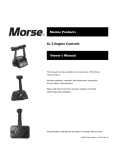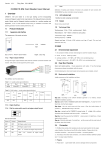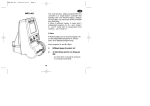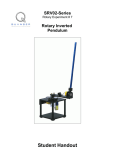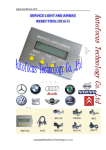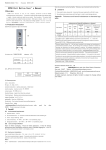Download Marine Cruise Control Operation Manual
Transcript
Marine Cruise Control Operation Manual Contents: 1. 2. 3. 4. 5. Warnings Operation Quick Start Guide Appendix Troubleshooting Guide I. Warnings: Page # 1 1 3 4 4 1. WARNING: If at any time Cruise Control does not operate as expected, turn off the ignition to the boat! Cruise Control is designed to automatically idle the engine whenever it loses power. Turning off the ignition will reset Cruise Control and stop the engine. 2. WARNING: DO NOT ENGAGE Cruise Control IN REVERSE! Cruise Control cannot differentiate between forward and reverse throttle. It only measures how far the throttle is positioned regardless of forward and reverse. Only use Cruise Control going forward. If Cruise Control is accidentally engaged in reverse, simply push the throttle handle back to idle or turn the ignition to off. II. Operation: WARNING: If at any time Cruise Control does not operate as expected, turn off the ignition to the boat! Cruise Control is designed to automatically idle the engine whenever it loses power. Turning off the ignition will reset Cruise Control and stop the engine. After Cruise Control is installed properly it will operate your boat using a “fly-by-wire” system. The internal computer will measure throttle movements through the throttle position sensor and translate that to carburetor adjustments using the internal stepper motor. The system will automatically start up when the ignition signal wire receives a 12V signal. No further action is needed for Cruise Control to operate the boat as usual. Throttle movements and engine responses may vary slightly from the original cable driven system, but that is normal. There will be one short beep when the throttle is pushed out of idle so the driver is aware of when the system is actively controlling the carburetor. This will aid the driver when resuming the cruise control from idle (see item E below). NOTE: Since Cruise Control uses a “fly-by-wire” system, it is critical that all sensors, plugs, wiring, cables and connections are installed and working properly. If the Cruise Control system does not operate the boat as usual, please re-check installation, calibration and/or refer to the Troubleshooting Guide. 1 Copyright © 2011 South Branch Controls. All rights reserved. In order to use the speed control functions of Cruise Control, follow these instructions: A. Set Cruise Speed – To set a cruise speed, get the boat up to the desired speed and click either UP (clockwise) or DOWN (counterclockwise) on the switch. There will be one long beep when the speed is set and the LED on the switch will turn on solid. This will be the set speed for the cruise control. The LED will stay lit whenever there is a set speed and the cruise control is engaged. B. Adjust Set Speed – The set speed can be changed at any time while engaged by clicking UP or DOWN on the switch. Each click up or down will change the set speed by one half (0.5) mph (0.8 kph) according to which direction the switch was clicked. Each time UP or DOWN is clicked, there will be one short beep and the LED will stay on. C. Disengage Cruise Control – Any movement of the throttle handle will disengage the cruise control. There will be one long beep when the cruise control disengages and the LED will begin to blink slowly. There will be a 10second delay before the throttle handle can re-engage the cruise control. The system can also be disengaged by pressing DOWN on the switch for two seconds. This however will also clear the set speed and the LED will turn off. D. Re-engage Cruise Control – While the LED is blinking slowly, simply accelerate the boat up to the set speed and the cruise control will automatically re-engage once the set speed is reached. When it re-engages, there will be one long beep and the LED will turn on solid. NOTE: After disengaging the cruise control, there is a delay of 10 seconds before the system can be re-engaged. This is to allow for the recovery of the rider without the system re-engaging. E. Resume Cruise from Idle – The system cannot be engaged, resumed or re-engaged from idle. However, this can be accomplished with the throttle handle just outside of idle. Also, a set speed must be set and the LED will be blinking slowly if there is a set speed. To resume the set speed from idle speed, push the throttle handle just past the idle detent. A short beep will sound when the throttle handle is not in idle. When the rider is ready to resume, press either UP or DOWN on the switch and the boat will accelerate at 100% WOT (wide open throttle) until it reaches the set speed. When UP or DOWN is pressed on the switch, the LED will turn on solid. HINT: If the driver wants to use the resume feature, it may be helpful to create a set speed before there is a rider in the water. Then when the rider is in the water, the set speed is already set and the resume feature can be used by the driver. F. Turn Off /Clear Set Speed – To turn the system off and to clear the set speed, press DOWN on the switch for two seconds and release. The LED will turn off to indicate that the set speed has been cleared. 2 Copyright © 2011 South Branch Controls. All rights reserved. Marine Cruise Control Quick Start Guide III. Read entire Installation and Operation Manual and Warnings before proceeding with any of the following: Operation: Step: Action(s): Set cruise speed Adjust set speed Disengage cruise control Re-engage cruise control Resume cruise control from idle Turn off - Clear set speed Notes: When boat is close to the desired speed, click UP or DOWN on the control switch Click control switch UP or DOWN to adjust cruise speed up or down by ½ mph per click Move throttle handle – any movement of the handle will disengage speed control Speed control will resume when the boat is accelerated to previous set cruise speed With Throttle Handle just barely out of idle (one (1) short beep will sound when out of idle), click UP or DOWN on Control Switch – boat will automatically accelerate at WOT to previous set cruise speed Press DOWN on control switch for two (2) seconds One (1) long beep LED will turn ON One(1) short beep for each click One (1) long beep LED will BLINK SLOWLY One (1) long beep LED will turn ON One (1) long beep LED will turn ON LED will turn OFF Calibration: Action(s): 1 2 3 4 5 6 7 8 Notes: Ignition - Turn on ignition, but NOT engine Start Calibration - Hold control switch up for ten (10) seconds Set Idle - With throttle handle at idle detent click control switch DOWN Set WOT on Throttle Handle - With throttle handle at WOT click control switch UP Carb Setting - with throttle handle in idle, hold UP for two (2) seconds Remove Slack - Push throttle handle to 50% WOT and quickly back to idle three (3) times – DO NOT SKIP THIS STEP! Set WOT on Carburetor - Slowly push throttle handle forward until carburetor is at WOT Finalize - Press control switch DOWN for two (2) seconds One (1) long beep LED starts BLINKING RAPIDLY One (1) short beep Two (2) short beeps Three (3) short beeps Control cable will tighten If cable becomes loose, repeat steps 6 and 7 One (1) long beep LED turns OFF Installation: Action(s): 1 Remove throttle cable from carburetor Attach the throttle cable to throttle position sensor 2 Attach the control cable to carburetor 3 Details: 4 Install control switch Connect 12V electrical supply and ignition 5 signal wire Connect GPS antenna 6 3 Remove nut from carburetor and cable mount Insert magnet into shuttle and through throttle cable Insert shuttle into throttle sensor housing (ensure magnet stays within range of sensor magnet) Insert throttle cable mounting bolt and attach locknut Mount throttle position sensor on transom & connect wire to control box Attach return/safety spring mount and attach return spring Attach return spring to carburetor bracket and slide onto carburetor Slide cable hanger onto throttle cable mount (Merc style) or mount cable barrel in mounting bracket (Volvo/Universal style) Thread control cable through cable hanger/barrel and cable anchor bolt and tighten cable anchor bolt with control cable slightly loose Run wires through mounting hole and attach to control box Attach 12V + and – wires to battery/fuse box (10 amp fuse) Attach ignition signal wire to the ignition signal post on the ignition switch Mount GPS antenna somewhere it will get full view of sky Run wire back to control box and connect Copyright © 2011 South Branch Controls. All rights reserved. IV. Appendix: LED Guide: LED Status: LED Off LED On Solid LED Blinking Slowly LED Blinking Rapidly Indication: No set speed, cruise control is off Cruise control engaged, set speed active Cruise control disengaged, set speed active, ready to re-engage or resume In calibration mode Switch Guide: Switch Movement: Click UP Click UP Click DOWN Click DOWN Hold DOWN 2 seconds Click UP When LED is: Off (system disengaged, no set speed) On (cruise engaged at set speed) Off (system disengaged, no set speed) On (cruise engaged at set speed) On (cruise engaged at set speed) Slow blink (cruise disengaged with set speed) Hold DOWN 2 seconds Hold UP 10 seconds Slow blink (cruise disengaged with set speed) Off (system disengaged, no set speed) V. 4 Action: Engages cruise control, sets speed Increases set speed by 0.5 mph (0.8 kph) Engages cruise control, sets speed Decreases set speed by 0.5 mph (0.8 kph) Turns cruise off and clears set speed Resume to set speed at WOT if throttle handle is not in idle Turns cruise off and clears set speed Begin calibration procedure Troubleshooting Guide: Cruise Control does not turn on – Check battery connections and fuse. Replace 10 amp fuse if necessary. Make sure ignition signal wire is connected and ignition is turned to the ON position. When calibrating idle or WOT, the system does not set the position – Review guidelines for installing the shuttle in the throttle position sensor. Make sure the magnet in the shuttle does not go beyond the limits of the long, flat magnet sensor on top of the throttle position sensor. If it does, adjust the length of the throttle cable by twisting either the throttle cable barrel (Merc.) or the cable end (Univ./Volvo) so that the shuttle magnet makes contact with the magnet sensor at all times. When driving the boat, the carburetor returns to idle – Review installation and calibration instructions and recalibrate if necessary. Pay careful attention to the installation of the throttle position sensor magnets. Cruise Control does not resume when UP or DOWN is clicked – Make sure the throttle handle is just slightly out of idle. There will be one short beep when the throttle handle leaves the idle position. When throttle handle is at WOT the carburetor is not fully opened – Re-calibrate system and ensure that the carburetor is at WOT before finalizing the calibration. Cruise Control does not engage – Ensure GPS antenna is placed so that it gets a full view of the sky. Make sure it is away from electrical interference from the engine, transducers, speakers, etc. Also, make sure the throttle handle is not in the idle position. Carburetor does not idle when throttle handle is in idle – Re-calibrate carburetor to ensure idle is set correctly. Also, sometimes an additional safety spring may be required to pull active carburetor back to idle. Throttle handle is pushed forward, but nothing happens – Check control cable anchor bolt and ensure that it’s tight. If it is not, tighten it according to the installation instructions and re-calibrate the system. When the throttle handle is pushed forward, the cable clicks, bumps, or jerks and does not move the carburetor – Make sure there are no kinks or hard bends in the control cable. Like the boat’s throttle cable, sharp bends or kinks create extra friction in the cable. Re-calibrate if necessary. Copyright © 2011 South Branch Controls. All rights reserved.







